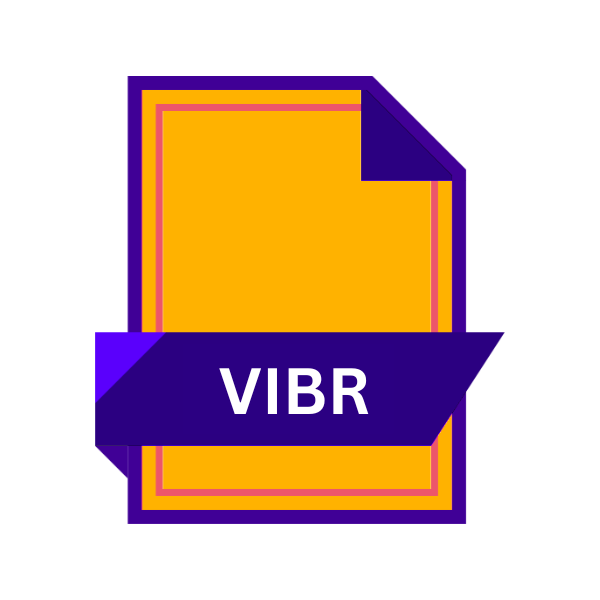.VIBR File Extension

Vibration Sequence File
| Developer | N/A |
| Popularity | |
| Category | Data Files |
| Format | .VIBR |
| Cross Platform | Update Soon |
What is an VIBR file?
In the realm of digital files, the .VIBR extension might seem unfamiliar to many. However, this seemingly obscure file format plays a crucial role in various industries, particularly in engineering, manufacturing, and simulation.
The .VIBR file, short for Vibration Sequence File, contains encoded data that describes vibration patterns, crucial for analyzing and simulating mechanical systems.
In this comprehensive guide, we delve into the origins, structure, applications, and accessibility of .VIBR files.
More Information.
The .VIBR file format can trace its roots back to the early days of computational engineering and simulation software. Initially, proprietary formats dominated the landscape, hindering interoperability and collaboration.
The emergence of .VIBR aimed to address these challenges by offering a standardized, platform-independent solution for storing vibration data.
Origin Of This File.
The .VIBR file format emerged from the necessity to store and analyze vibration data efficiently. As industries advanced, the need for precise monitoring and simulation of mechanical systems grew.
Engineers and researchers required a standardized format to store vibration sequences, enabling seamless sharing and analysis across different platforms and software.
File Structure Technical Specification.
A .VIBR file typically consists of structured data representing vibration sequences. The exact structure may vary depending on the software or application generating the file. Common elements include:
- Header: Contains metadata such as file version, creation date, and description.
- Time Series Data: Encodes vibration amplitude and frequency information over time.
- Event Markers: Optional markers indicating significant events or transitions in the vibration sequence.
- Footer: Concludes the file with checksums or additional metadata for validation.
How to Convert the File?
Converting .VIBR files to other formats or vice versa may be necessary to facilitate compatibility or interoperability. Below are some methods and tools for converting .VIBR files, depending on the desired output format and platform:
- Using Engineering Software: MATLAB or ANSYS provide built-in functions for importing and exporting .VIBR files, making conversion straightforward within their respective environments.
- Third-Party Tools: Python libraries like Pandas and NumPy offer customizable scripts for converting .VIBR files to formats such as CSV or Excel, while online converters provide a quick solution for simple conversions.
- Custom Scripts: Develop Python or MATLAB scripts tailored to your needs for precise control over conversion processes, ensuring seamless integration with your workflow.
- Consider Compatibility: Choose tools compatible with your operating system (Windows, Linux, macOS) to ensure smooth execution of conversion tasks. Opt for cross-platform solutions like Python for versatility across different systems.
Advantages And Disadvantages.
Advantage:
- Standardization: .VIBR offers a standardized format for storing vibration data, promoting interoperability among different software and platforms.
- Efficiency: The file format is designed for efficient storage and retrieval of vibration sequences, optimizing performance in simulation and analysis.
- Compatibility: .VIBR files can be seamlessly integrated into various engineering software packages, enhancing collaboration and workflow efficiency.
Disadvantage:
- Limited Adoption: Despite its advantages, the .VIBR file format may suffer from limited adoption outside specific industries or applications.
- Complexity: Understanding and working with .VIBR files may require familiarity with vibration analysis techniques and specialized software tools.
- Proprietary Dependencies: Some .VIBR files may be generated or optimized for specific software packages, limiting compatibility with other applications.
How to Open VIBR?
Open In Windows
- Use Compatible Software: Various engineering software packages on Windows, such as MATLAB or ANSYS, support opening and working with .VIBR files directly.
- Conversion Tools: Third-party conversion tools or plugins may offer the capability to convert .VIBR files to common formats like CSV or Excel, which can be opened using native Windows applications.
Open In Linux
- Command-Line Tools: Linux users can leverage command-line tools like Pandas or NumPy to read and manipulate .VIBR files for analysis or conversion.
- Custom Scripts: Developing custom scripts or utilities using Python or other programming languages can provide tailored solutions for working with .VIBR files in Linux environments.
Open In MAC
- Engineering Software: Mac users can utilize engineering software packages compatible with macOS, such as MATLAB or Simulink, to open and analyze .VIBR files.
- Cross-Platform Tools: Some cross-platform analysis tools like Python libraries or Jupyter notebooks can seamlessly run on macOS and handle .VIBR files with ease.
Open In Android
- Mobile Applications: Android users may find specialized mobile applications designed for vibration analysis or engineering simulations capable of opening .VIBR files directly.
- Cloud Services: Leveraging cloud-based engineering platforms accessible from Android devices can provide convenient access to .VIBR files for analysis and collaboration.
Open In IOS
- Cloud Services: iOS users can access cloud-based engineering platforms or applications compatible with .VIBR files for analysis and simulation tasks.
- Remote Desktop Solutions: Utilizing remote desktop solutions to access Windows or macOS environments from iOS devices enables opening .VIBR files using compatible software.
Open in Others
- Web-Based Tools: Online platforms or web applications may offer the capability to upload and analyze .VIBR files, providing cross-platform accessibility from any device with a web browser.
- Virtualization: Utilizing virtualization technologies to run Windows or Linux environments on other operating systems allows opening .VIBR files using compatible software within a virtualized environment.













